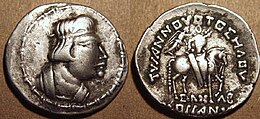




In the coinage of the North Indian and Central Asian Kushan Empire (approximately 30–375 CE) the main coins issued were gold, weighing 7.9 grams, and base metal issues of various weights between 12 g and 1.5 g. Little silver coinage was issued, but in later periods the gold used was debased with silver.[1]
The coin designs usually broadly follow the styles of the preceding Greco-Bactrian rulers in using Hellenistic styles of image, with a deity on one side and the king on the other. Kings may be shown as a profile head, a standing figure, typically officiating at a fire altar in Zoroastrian style, or mounted on a horse. The artistry of the dies is generally lower than the exceptionally high standards of the best coins of Greco-Bactrian rulers. Continuing influence from Roman coins can be seen in designs of the late 1st and 2nd century CE, and also in mint practices evidenced on the coins, as well as a gradual reduction in the value of the metal in base metal coins, so that they become virtual tokens. Iranian influence, especially in the royal figures and the pantheon of deities used, is even stronger.[2] Under Kanishka the royal title of "King of kings" changed from the Greek "ΒΑΣΙΛΕΥΣ ΒΑΣΙΛΕΩΝ" to the Persian form "ϷAONANOϷAO" (Shah of Shahs).[3]
Much of what little information we have of Kushan political history derives from coins. The language of inscriptions is typically the Bactrian language, written in a script derived from Greek. Many coins show the tamga symbols (see table) as a kind of monogram for the ruler. There were several regional mints, and the evidence from coins suggests that much of the empire was semi-independent.
- ^ "ONSNUMIS.ORG – Kshaharata Questions". 2021-08-03. Archived from the original on 3 August 2021. Retrieved 2022-02-26.
- ^ MacDowell, "Mithra"
- ^ MacDowell, "Mithra", 308–309
